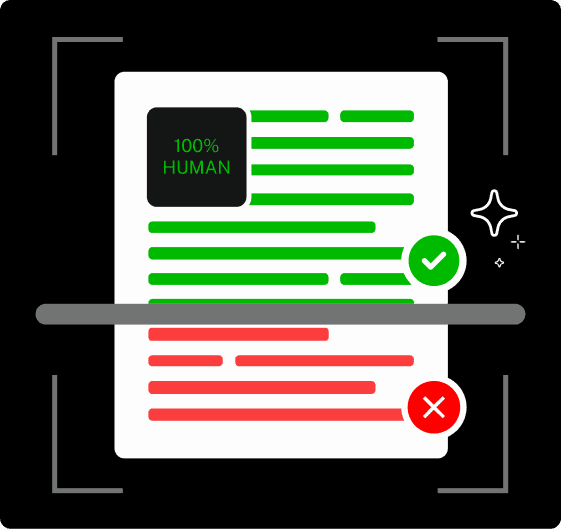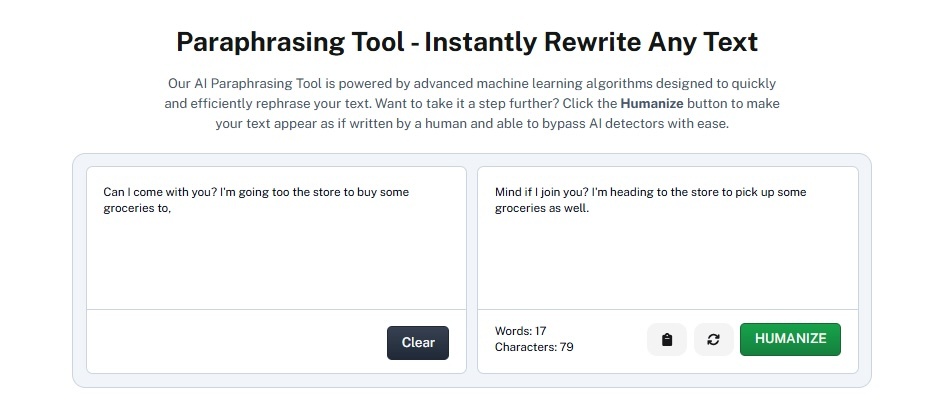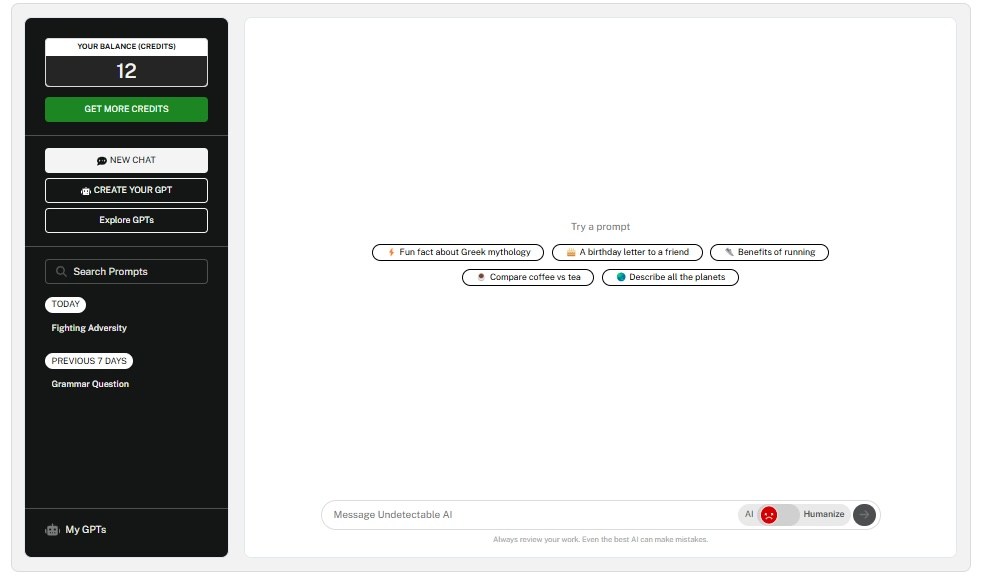Today, we’re tackling one of the oldest grammar crimes in the book: choosing between to and too.
Let’s get one thing straight—we’re not dealing with the number two here, even though all three are homophones.
Most to vs too mistakes happen in writing, and regularly make it onto Oxford’s top grammar blunders list.
It’s easy to see why, as these words are only one letter apart. The real challenge, most of the time, is using the right word in the right context rather than a similar but improper one.
So, how do you know which one to use? What’s the actual difference between them?
Here’s everything you need to know about the difference between to and too.
“To” – Definition and Usage

“To” is one of the hardest-working words in the English language.
It’s the third most-used word in the English language as it serves multiple grammatical functions.
Let’s break it down:


Never Worry About AI Detecting Your Texts Again. Undetectable AI Can Help You:
- Make your AI assisted writing appear human-like.
- Bypass all major AI detection tools with just one click.
- Use AI safely and confidently in school and work.
As a preposition, “to” indicates movement, direction, or destination:
- “I’m going to the store.”
- “Hand the report to your manager.”
- “The package was delivered to her yesterday.”
As part of an infinitive verb form, “to” creates the base form of a verb:
- “I want to sleep.”
- “She needs to finish her assignment.”
- “They decided to cancel the meeting.”
You’ll find “to” in countless phrases indicating relationships:
- “I’m allergic to peanuts.”
- “They’re committed to excellence.”
- “She’s addicted to coffee.”
Notice how “to” creates a connection between things. It’s a linking word that shows relationship, direction, or purpose.
If you’re struggling to know when to use “to,” remember it’s almost always about connection or direction.
Think of “to” as an arrow pointing from one thing toward another.
“Too” – Definition and Usage

Unlike its cousin “to,” the word “too” serves a completely different purpose.
“Too” functions as an adverb with two primary meanings:
As a synonym for “also” or “as well”:
- “I love pizza too.”
- “She’s coming to the party too.”
- “The movie was good, and the popcorn was too.”
To indicate excess or more than enough:
- “The coffee is too hot to drink.”
- “He’s driving too fast.”
- “This backpack is too heavy for a child.”
The word “too” adds emphasis or includes something additional. It’s never used to show direction or as part of a verb form.
A helpful trick: “Too” has an extra “o” – just like it means something extra or additional!
Common Mistakes with “To” and “Too”
Even skilled writers sometimes mix up these words.
Here are the most common mistakes:
Using “to” when you mean “also”:
- Incorrect: “I want to go to the beach to.”
- Correct: “I want to go to the beach too.”
Using “too” as a preposition:
- Incorrect: “I’m going too the store.”
- Correct: “I’m going to the store.”
Forgetting that “too” means excess:
- Incorrect: “This box is to heavy.”
- Correct: “This box is too heavy.”
Autocorrect and spellcheck won’t always catch these errors because both words are spelled correctly.
The problem is using the right word in the right context.
Get it wrong in a text to a friend, and it won’t matter so much, but get it wrong when writing college essays, and it could hurt your credibility.
Remember that context is everything. Ask yourself: Am I indicating direction or a relationship? Then use “to.” Am I adding emphasis or indicating excess? Then use “too.”
How to Remember the Difference

Struggling to keep these straight? Here are some foolproof memory tricks:
- The Extra “O” Trick: “Too” has an extra “O” – just like it means something extra or in addition to.
- The Substitution Test: If you can replace the word with “also” or “excessively” and the sentence still makes sense, you need “too.”
- The Direction Test: If you’re showing movement, destination, or connection, you need “to.”
Let’s see these tricks in action:
“I want to go to the store too.”
- Can “too” be replaced with “also”? Yes! “I want to go to the store also.” So “too” is correct.
- Is the first “to” part of the verb “to go”? Yes! So “to” is correct.
- Is the second “to” showing direction? Yes! So “to” is correct.
These simple tests will help you make the right choice every time.
Examples in Real Sentences
Nothing beats examples for cementing your understanding.
Here’s “to” and “too” in action:
With “to”:
- “Jane handed the report to her boss.”
- “We’re going to try to finish this project by Friday.”
- “The path to success is often challenging.”
- “She likes to swim in the mornings.”
With “too”:
- “The water is too cold for swimming.”
- “I love chocolate ice cream too!”
- “He talks too much during meetings.”
- “The deadline is too soon for us to complete the task.”
Mixed examples:
- “I’m going to invite Sam to the party too.”
- “It’s too late to change your flight.”
- “Alex wants to go too, but he needs to finish his homework first.”
Practice: To or Too?
Test your knowledge with these practice sentences.
Fill in the blank with either “to” or “too”:
- I want ___ go ___ the movie theater ___.
- It’s never ___ late ___ start a new hobby.
- She speaks ___ quickly for me ___ understand.
- We’re planning ___ visit Paris ___.
- The coffee is ___ hot ___ drink right now.
Answers:
- I want to go to the movie theater too.
- It’s never too late to start a new hobby.
- She speaks too quickly for me to understand.
- We’re planning to visit Paris too.
- The coffee is too hot to drink right now.
How did you do? If you got any wrong, review the rules and try again!
Use AI to Instantly Check Your Grammar
Today, AI tools have become reliable writing assistants.
Undetectable AI offers powerful features to help you perfect your writing.
The Paraphraser tool from Undetectable AI does more than just rephrase content. It can actually fix grammar errors like “to” vs “too” mistakes.
Here’s how:
- Write your text with questionable “to/too” usage.
- Paste it into the Paraphraser tool.
- Select your preferred style (formal, casual, etc.).
- Click “Paraphrase” and watch the magic happen.
For example, if you type: “Can I come with you? I’m going too the store to buy some groceries to,”

The tool will correct it to: “Mind if I join you? I’m heading to the store to pick up some groceries as well.”
Beyond the Paraphraser, Undetectable AI’s Ask AI Chat tool offers personalized grammar help.
Simply paste in your paragraph and ask, “Are my ‘to’ and ‘too’ uses correct?” The AI will review your text and provide specific feedback.

This is particularly helpful for longer documents where manually checking each instance would be time-consuming.
The AI highlights each usage and explains why it’s correct or incorrect, helping you learn the rules while fixing your text.
For writers who regularly struggle with these words, using AI as a second pair of eyes can prevent embarrassing mistakes before they reach your readers.
Don’t be afraid to use these tools to help you write.
Tools like these are commonly used in academic writing assistance cases, primarily for improving readability and grammar checking.
Curious about our AI Detector and Humanizer? Try them in the widget below!
FAQs: To vs Too
Can “too” ever start a sentence?
Absolutely! “Too” can start a sentence, usually for emphasis:
– “Too many people ignore the warning signs.”
– “Too often we forget to appreciate what we have.”
Starting a sentence with “too” meaning “also” is less common but still correct:
– “Too did she mention the budget concerns.” (Though this sounds formal and a bit archaic.)
Modern writers typically place “too” meaning “also” at the end of a sentence or after the subject:
– “She, too, was concerned about the outcome.”
– “I was worried about that too.”
Is it ever okay to write “to too”?
Yes! While it looks strange, the phrase “to too” is grammatically correct when each word serves its proper function:
– “I’m going to too many parties this weekend.”
– “His dedication to too many projects caused burnout.”
In these examples, “to” functions as a preposition or part of an infinitive, while “too” indicates excess.
Though grammatically correct, writers often rephrase these sentences to avoid the awkward “to too” combination.
What about “two”?
Adding “two” to the mix creates even more potential for confusion! “Two” is strictly a number:
– “I have two dogs.”
– “The recipe calls for two eggs.”
A sentence might legitimately use all three words:
– “I want to give two roses to you too.”
Remember: “two” is always about the number 2, never interchangeable with “to” or “too.”
Finding Too Many Mistakes? Not Anymore.
Mastering “to” vs “too” is a seemingly small detail that makes a big difference in your writing.
These little words carry important meaning, and using them correctly signals your attention to detail.
Like any writing skill, proper usage becomes second nature with practice. Start by consciously checking each instance in your writing.
Soon, you’ll instinctively know which word fits.
When in doubt, remember our simple tricks:
- “To” connects things or shows direction
- “Too” has an extra “O” and means “extra” or “also”
Professional editors often say that seemingly small grammar issues like “to” vs “too” can undermine otherwise excellent writing.
Why? Because readers notice these errors immediately, even if they can’t articulate the grammar rule you’ve broken.
Our AI Paraphrasing tool can help catch these subtle slip-ups while teaching you why they matter, so you improve as you go.
What other commonly confused words trip you up? From “their/there/they’re” to “affect/effect,” mastering these distinctions elevates your writing from good to great.
Keep learning, keep practicing, and remember: even professional writers need to double-check!
